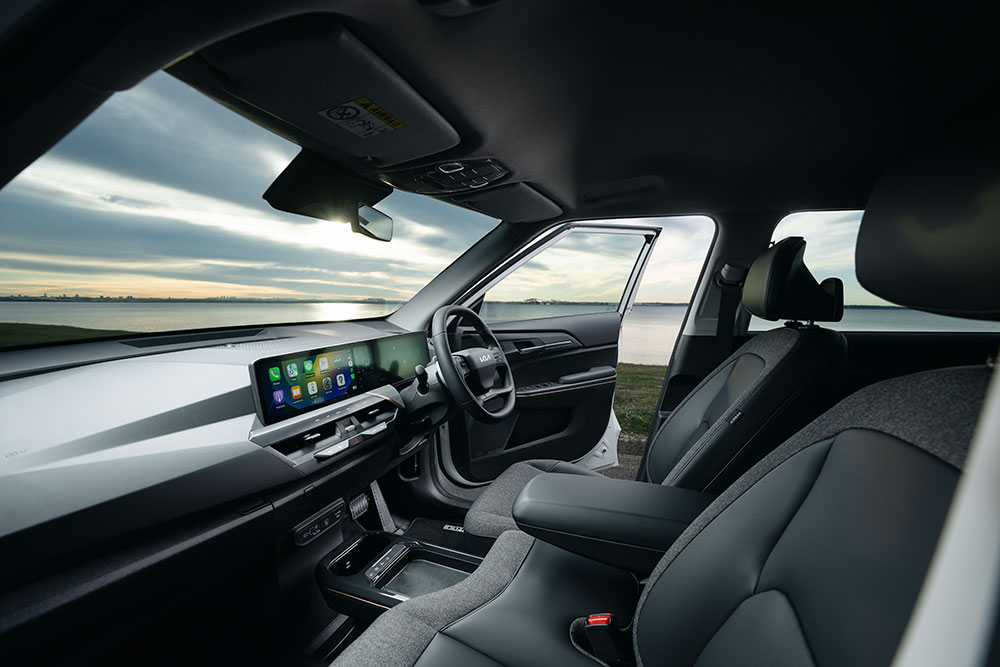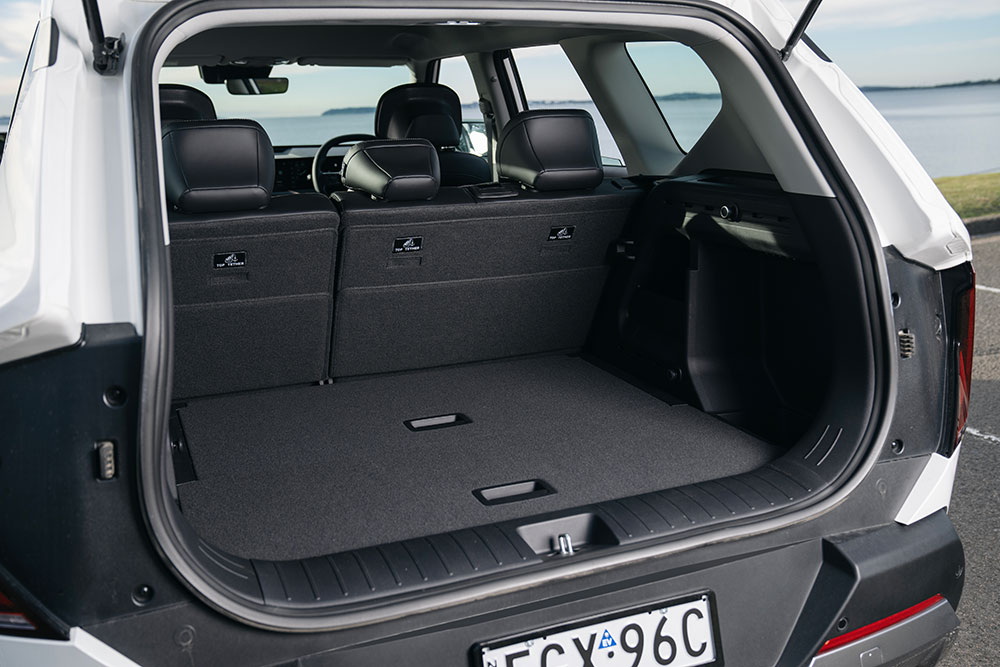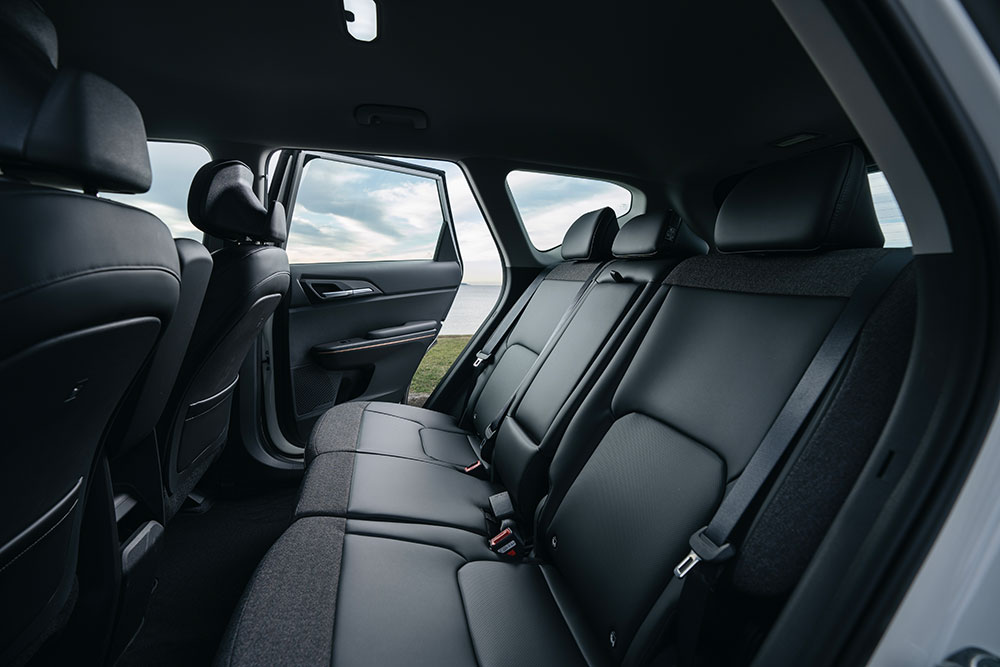Kia EV5 Air 2WD Long Range review
Kia lobs a smartly designed and well-priced electric mid-sized SUV right into the path of Tesla’s all-conquering Model Y.

Like its stablemate and platform partner Hyundai, Kia’s push into the electric vehicle space has been steadily consistent, with its EV-only range initially including the EV6 large SUV launched in early 2022, followed that same year by the updated Niro EV, and in late 2023 by the larger EV9 seven-seater SUV.
While the Niro SUV has the compact end of the EV market covered, and the EV6 and EV9 fill the large and upper-large SUV segments respectively, what Kia really needed was a mid-sized EV to do battle with the likes of the market-leading Tesla Model Y.
Enter the EV5, described by the car maker as a fully electric medium SUV “designed to meet the needs of families, individuals and fleet customers.”
Like the Model Y, the EV5 is sourced from China and has the distinction of being the first right-hand drive model and the first export model to emerge from the Korean car maker’s factory there.
It’s also a possible pointer of what’s to come as Kia and other car makers strive to remain competitive with cut-price Chinese EVs – and with China’s growing expertise in the field of batteries and battery electric vehicles.
Kia says that sourcing Australian EV5 stock from China rather than its South Korean factory – which comes online some six to 12 months after the Chinese plant – allowed the company to launch the vehicle sooner and eliminates competition with Europe for supply.
The Chinese factory is also able to guarantee supply of up to 850 vehicles per month, which Kia believes is needed for the EV5 to target mainstream appeal.
Kia’s previous best-selling dedicated electric model, the EV6, manages around 155 sales per month, while the larger seven-seat EV9 sells around 48 units per month. The Niro is available in both petrol-hybrid and electric and sells around 127 vehicles sold per month.
Considering rival Tesla typically sells around 1760 Model Y per month, Kia clearly sees the potential for the EV5 to quickly become its best-selling EV and has set a sales target of around 400 EV5s per month with a 60/40 split in favour of fleet sales.

How much does the Kia EV5 cost?
With Tesla cutting the price of its best-selling Model Y repeatedly during 2024 and the EV market generally becoming increasingly price-sensitive, Kia is acutely aware of the importance of landing the EV5 with a competitive price tag.
It should come as no surprise then that entry-level pricing of the brand’s new electric SUV closely tracks that of the Model Y.
Tesla’s base-model Rear-Wheel Drive variant starts at $55,900 (MRLP), rising to $69,900 for the Long-Range All-Wheel Drive, and $82,900 for the Performance All-Wheel Drive.
The EV5 range meanwhile, kicks off with the entry-level EV5 Air 2WD Standard Range, at $56,770 (MRLP), moving up to the EV5 Air 2WD Long Range at $61,170 (MRLP), onto the mid-grade EV5 Earth AWD at $64,770 (MRLP), and topping out with the EV5 GT-Line AWD at $71,770 (MRLP).
Kia doesn’t yet have an EV5 equivalent for Tesla’s Performance All-Wheel Drive.
The model we’re focused on here is the EV5 Air 2WD Long Range priced at $61,170 (MRLP), the closest Tesla to which is the base- model Rear-Wheel Drive at $55,900 (MRLP).
What sort of technology does the Kia EV5 have?
The EV5 is built on a dedicated EV platform called N3 eK which is different to the E-GMP platform used on Kia’s existing EV6 and EV9 models.
The EV5 also utilises a high-efficiency lithium iron phosphate (LFP) battery, instead of the lithium-ion batteries used in the brand’s other EVs.
The battery is arguably the most important part of any electric car’s technology package and LFP batteries are designed to provide a higher power density than lithium-ion batteries, which Kia says makes them better suited for high-drain applications such as electric vehicles.

The EV5 is available with two different battery sizes, the EV5 Air 2WD Standard Range gets a 64.2 kWh battery, while the EV5 Air 2WD Long Range and both AWD models feature a larger 88.1 kWh battery.
The Air 2WD with the smaller battery can accommodate AC charging at up to 7kW only, where the models equipped with the larger battery can charge at up to 11W AC (3 Phase).
Kia says that charging these 88.1 kWh battery-equipped models from 10–100% on an 11kW charger takes just over eight hours.
All EV5 variants can accommodate DC charging up to 350kW, with the larger battery models taking an estimated 72 minutes for a 10–80% charge on a 50kW DC charger, or 38 minutes for the same charge on a 350kW charger.
Standard across the range is Kia Connect which allows drivers to access the vehicle via a smart phone, to warm up or cool down the interior before driving, find the car in a car park, and remotely check on the vehicle status including battery level and range.
The app can also be used to lock and unlock the vehicle, start and stop charging, open the charging door, and pre-condition the battery before charging.
Another important function of Kia Connect is that it enables OTA (over-the-air) updates, which means vehicle software can be upgraded to the latest version automatically, just like on your iPhone, without requiring a dealership visit.
There’s an internal vehicle-to-load (V2L) port on all models to enable the powering of electrical appliances, with the Earth and GT-Line also boasting an exterior V2L port which can be added as a factory accessory on the Air.
What’s the exterior design of the Kia EV5 Like?
Stylistically, the EV5 follows the chunky, squared-off styling of the EV9 rather than the smooth curves of the EV6.
The wide nose and solid bonnet give it a muscular, planted look, which is enhanced by a rugged-looking lower skid plate.
In side view, the mid-sized EV is chunky and angular looking, with flush-fit door handles, roof rails, and alloy wheels in three different sizes.
The Air rolls on modestly proportioned 18-inch alloys, the Earth gets 19s, while the top-of-the-line GT-Line sits on guard-filling 20s.
Oher notable exterior design elements of the EV5 Air include matte black colouring for the wheel-arch mouldings, front and rear bumper, skid plate surrounds and roof racks, LED headlights, DRLs and taillights, solar glass, and power folding door mirrors.
Dimensionally, the EV5 is the same length as Toyota’s popular hybrid-powered RAV4 but is slightly taller (+25mm) and wider (+10mm), and rides on a 60mm longer wheelbase.
The tale of the tape is largely reversed when compared with the Tesla Model Y, however, which is longer (+136mm), wider (+46mm) and sits on a longer wheelbase (+140mm), although the EV5 is 91mm taller than the Tesla.
Supercharge your drive with Evie's fast charging
What’s the interior of the Kia EV5 like?
The EV5’s long wheelbase and wide body translate into a pleasingly roomy interior with good space for front and rear seat passengers.
In fact, Kia claims the EV5 interior offers more second-row leg room and headroom than the Model Y, and superior shoulder room in both rows.
All EV5 variants come with dual 12.3-inch screen displays incorporating a 5.0-inch bridging segment and featuring Kia’s updated GUI (graphical user interface).
It looks suitably futuristic inside, as a result, with the impressive integrated panoramic display running halfway across the dash.
Elsewhere, the design is clean, uncluttered and attractive but Kia has thankfully retained some switchgear, including a row of touch-type buttons below the infotainment screen for quick access to regularly used functions.
The seats are clad in a mix of fabric and artificial leather in a smoky black trim, with grey headliner contributing to a reasonably classy feeling cabin.
Materials step up noticeably as you move up the grades, including the GT-Line with its two-tone dash and artificial leather, with the result that the Air does feel a bit fleet spec with its dark plastic trim compared with these variants.
Despite this, it’s quite well equipped even at this entry grade, with heated front seats, power driver seat with four-way lumbar adjustment and massage function, LED interior lighting, power windows, and an artificial leather four-spoke steering wheel.
Other standard kit includes inbuilt navigation, a six-speaker sound system, 12V outlet in the front console, USB-C chargers in the front and rear, rain-sensing wipers, and a smart key with remote engine start.

An unusual interior design element is the front passenger seat, which has a base that extends across to cover the area where a centre console might normally be.
It looks like a centre seat, but there’s no third seatbelt and the folding centre armrest sits over the top, meaning it’s a redundant piece of upholstery that takes up space that could otherwise be used for storage.
Fortunately, there’s plenty of storage elsewhere, thanks in part to the use of a column shift-mounted gear selector with push-button start integration which frees up space in the centre console area.
There’s also a larger space under the console big enough to store a handbag and a small drawer accessible from the back seat that extends out of the centre console for additional storage.
The drawer is heated and chilled in the top-spec GT-Line so can be used for keeping food and drinks hot or cold.
There’s a 67-litre front trunk in both 2WD and AWD models and a generous 513-litre (VDA) boot. By comparison, the Model Y boasts a larger 117-litre front trunk and an 854-litre boot, although Tesla doesn’t use the same VDA measurement, meaning its boot space is measured to the roof, as opposed to the top of the seats.
The Kia’s 60-40 split-fold second row of seats folds fully flat for additional luggage capacity and the boot also features additional underfloor storage and adjustable luggage hooks.
What’s the Kia EV5 like to drive?
A key point of difference between the 2WD Tesla and the equivalent EV5 variants is the Tesla drives its rear wheels, while the 2WD EV5s are both front-wheel drive.
Most people won’t notice which end is doing the driving most of the time, but give the EV5 FWD too much gas when exiting a corner or an intersection and the effects of sending V8-like torque through the front hoops is instantly felt through the steering.
This is a slightly inconvenient truth, given that Kia has previously highlighted the virtues of rear-wheel drive dynamics with 2WD versions of its EV6 and EV9.
Kia for its part says that sending the drive forwards, rather than rearwards avoids the drive squat that can accompany high-torque rear-wheel drive cars, but there are also other more pragmatic reasons including vehicle packaging and cost.
Despite this, the EV5 does a generally good job of marking its front-drive origins. Like most EVs, it’s impressively quiet at road speeds and delivers its power in a smooth and linear fashion that makes for pleasurable open-road performance with effortless overtaking ability.
There’s no shortage of performance even in the Standard and Long-Range single-motor 2WD Air variants with their outputs of 160kW/310Nm, while the AWD Long Range EV5 Earth and GT-Line boost this to 230kW/480Nm courtesy of their twin electric motors.
Kia claims the EV5 Air Standard Range dispatches the 0–100km/h in 8.5 seconds versus 8.9 seconds for its heavier Long-Range stablemate.
The dual-motor EV5 GT-Line covers the 0–100km/h sprint in 6.3 seconds, with the mechanically identical but lighter Earth variant the quickest in the range at 6.1 seconds.
By way of comparison, the single motor Model Y Rear-Wheel Drive delivers estimated outputs of 220kW/420Nm, the Long-Range AWD ups this to an estimated 378kW/493Nm, while the range-topping Model Y Performance punches out an estimated 393kW/639Nm.
Hence, if performance is your primary focus the Model Y has the EV5 well and truly covered, with the Rear-Wheel Drive covering the 0-100km/h sprint in a claimed 6.9 seconds, the Long-Range AWD in 5.0 seconds, and the Performance in a blistering 3.7 seconds.
Given that the EV5 is pitched more as a family-friendly EV than a sprinter, there are of course other things to consider, including ride comfort and interior accommodation, both areas where the EV5 performs well.
Kia’s well-regarded Australian ride and handling development team were involved in refining the suspension calibration for local conditions, resulting in a nicely balanced and predictable vehicle that errs more towards comfort than sports handling.
The FWD and AWD models have a different suspension tune but the main differences come down to battery weight and wheel-tyre combinations.

A spirited run through a section of road comprising a sequence of corners with mid-corner bumps served to highlight the weight of the cars, and the challenge the suspension faces in controlling the body and battery mass.
The setup does a good job for the most part but the EV5 doesn’t particularly like rapid directional changes with the suspension under load, and it feels less composed when pressed through corners than its stablemate the EV6.
In these conditions in 2WD models the traction control system can also prompt a hesitation in power delivery if it deems the driver is applying too much throttle too early when exiting a bend.
The EV5 Earth AWD proved better in this regard but comes on lower-profile 19-inch wheels and tyres which introduces some niggle to the ride equation and slightly more tyre noise than the base variants.
It’s worth noting at this point that we drove only 2WD Air and AWD Earth variants at the local launch, with the GT-Line unavailable, so we can make no comment on the dynamic performance of the top-of-the-line model on its 20-inch wheel and tyre combination.
Of the variants we did drive, the entry-level EV5 Air 2WD Standard Range is clearly the pick for ride quality, thanks to its smaller and lighter battery and more comfort-oriented 18-inch wheel and tyre combination.
However, both the 2WD variants exhibited torque steer that’s not present in the AWD model and which detracts from the overall drive experience.
Drivers who are particularly attuned to vehicle dynamics will almost certainly prefer the extra grip, cleaner steering, and more neutral cornering feel of the AWD variants, even if it comes at some cost to ride quality.
Incidentally, if you’re wondering what sort of difference the larger battery makes to the weight of the 2WD models, the answer is 145kg.
So, to travel the extra 155km afforded by the Long-Range battery you need to haul the equivalent weight of an extra two medium-sized passengers.

What sort of safety features does the Kia EV5 have?
The Kia EV5 has all the active and passive safety technology we’ve come to expect in a new Kia. This includes seven airbags including a front centre-side airbag and an extensive array of advanced drive assistance (ADAS) features.
The latter includes lane follow assist, blind-spot collision avoidance assist, multi-collision braking, highway drive assist, rear cross-traffic collision avoidance assist, and autonomous emergency braking with junction turning, junction crossing,lane oncoming and lane direct capability.
Over and above this, Kia points to the EV5’s high-strength body structure, a claim backed up by October 2024 ANCAP safety testing that saw all variants achieve a five-star rating.
ANCAP said its testing revealed good overall performance for the EV5, including an impressive vehicle-to-vehicle compatibility score.
Maximum points were scored for the driver in the side impact test; both child dummies in the frontal offset test; AEB car-to-car collision avoidance performance; and for its post-crash credentials including multi-collision braking, vehicle submergence countermeasures, and provision of a first-responder rescue sheet.
Let us do the work finding your next new car
Should I buy a Kia EV5?
Kia’s new Tesla fighter is an attractively designed and practical SUV that’s right-sized to appeal to smaller families.
It’s well finished inside and out, even if the interior plastics appear to be a slightly lower grade than what we’ve come to expect from Kia, particularly in the entry-level models without the classier two-tone finishes.
The driving range of the entry-level variant at 400km is about the minimum that’s acceptable in this country, but the Air 2WD Long Range pushes this out to a more manageable 550km for a not much higher price.
We didn’t drive the top-spec GT-Line so can’t comment on its dynamics, but it is the best-looking EV5 and has some neat additional features not found on other variants.
Budget-conscious buyers who don’t routinely drive in slippery conditions probably don’t need the extra grip of the AWD variants, although they do also bring the benefits of extra power and torque which some drivers will appreciate.
Based on this, the Air 2WD Long Range appears to be the sweet spot for range and value, with our only hesitation being the torque steer resulting from its front-wheel drive layout.
Key stats
- Price (MRLP): $61,170 (MRLP)/$63,990 (driveaway)Warranty: Seven years/unlimited km (vehicle), seven years/150,000km (high-voltage battery)
- Pre-paid service plan: Three years $980/five years $1,535/seven years $2,431
- Powertrain: 88.1 kWh Lithium Iron Phosphate (LFP) battery, single electric motor, front-wheel drive (160kW/310Nm)
- Energy consumption (WLTP): 18 kWh/100km
- Range (WLTP): 555km
- ANCAP crash rating: Five stars (Oct 2024)
- For: Right sized for smaller families, reasonably priced, attractively styled, roomy and practical interior, decent range and performance, strong safety package.
- Against: No spare wheel (tyre repair kit), extra weight of the battery tests the suspension on challenging roads, torque steer in 2WD variants, less powerful and more expensive than its key rival.
Related topics
Things to note
The information in this article has been prepared for general information purposes only and is not intended as legal advice or specific advice to any particular person. Any advice contained in the document is general advice, not intended as legal advice or professional advice and does not take into account any person’s particular circumstances. Before acting on anything based on this advice you should consider its appropriateness to you, having regard to your objectives and needs.
Insurance Products (excluding Travel Insurance) are issued by RACQ Insurance Limited ABN 50 009 704 152 (RACQI) and arranged by its agent, RACQ Distribution Services Pty Ltd (RDS) ABN 35 116 361 650, AFSL 567130 and RDS' authorised representatives (including RACQ Operations Pty Ltd ABN 80 009 663 414, AR No. 234978 (RACQO). Conditions, limits and exclusions apply. RDS and RACQO are in the RACQ group of companies. One of the companies in the RACQ group of companies has a minority shareholding in RACQI.
RDS and RACQO have not taken your personal objectives, circumstances or needs into account when preparing advice regarding insurance products and you will need to consider whether the advice is appropriate for you. Read the Product Disclosure Statement (PDS) and any applicable Supplementary PDS before making a purchase decision on this product. You can also access our Target Market Determinations on this website. RDS receives a commission from RACQI for the policies it arranges. RACQO receives fees paid for services it provides to RDS. Further details about remuneration are available on request prior to purchasing.
Banking and loan products issued by Members Banking Group Limited ABN 83 087 651 054 AFSL/Australian credit licence 241195 trading as RACQ Bank. Terms, conditions, fees, charges and lending policies apply. This is general advice only and may not be right for you. This information does not take your personal objectives, circumstances or needs into account. Read the disclosure documents for your selected product or service, including the Financial Services Guide and the Terms and Conditions, and consider if appropriate for you before deciding.
Except for RACQ Bank, any RACQ entity referred to on this page is not an authorised deposit-taking institution for the purposes of the Banking Act 1959 (Cth). That entity’s obligations do not represent deposits or other liabilities of RACQ Bank. RACQ Bank does not guarantee or otherwise provide assurance in respect of the obligations of that entity, unless noted otherwise.
RACQ Bank subscribes to the Customer Owned Banking Code of Practice which establishes higher standards than the law requires. The Code reflects modern consumer expectations and developments in approaches to issues such as consumer vulnerability, guarantors, and supporting customers through financial hardship. Please read our Customer Owned Banking Code of Practice page for more information.
RACQ Operations Pty Ltd (ABN 80 009 663 414 AR 000234978) and Members Travel Group Pty Ltd (ABN 45 144 538 803 AR 000432492) are acting as an Authorised Representative of the issuer of the insurance, Tokio Marine & Nichido Fire Insurance Co., Ltd. (ABN 80 000 438 291 AFSL 246 548). Any advice set out above is general in nature only, and does not take into account your objectives, financial situation or needs. Before purchasing any travel products, please consider the RACQ Travel Insurance Product Disclosure Statement (PDS) and the Target Market Determinations (TMDs) that apply to these products. Whilst the PDS outlines the Terms and Conditions of these products, the TMDs outline the intended class of customers that comprise the target market for these travel products. This will allow you to consider which products best suit your objectives, financial situation and needs and consider the products appropriateness to your personal circumstances. TMDs also outline matters involving the distribution and the review of these products. The PDS, Supplementary PDS and TMDs for each travel product can be found here.
